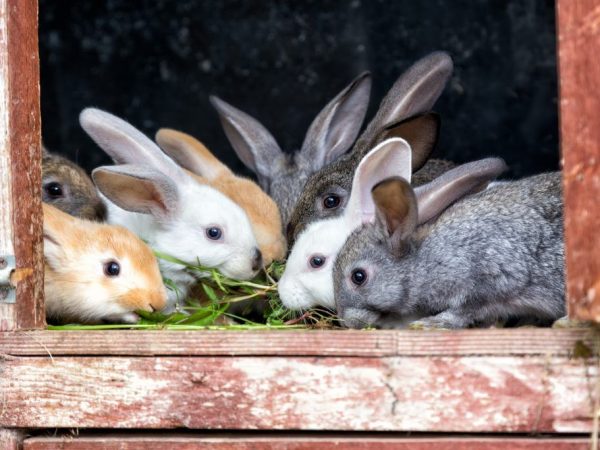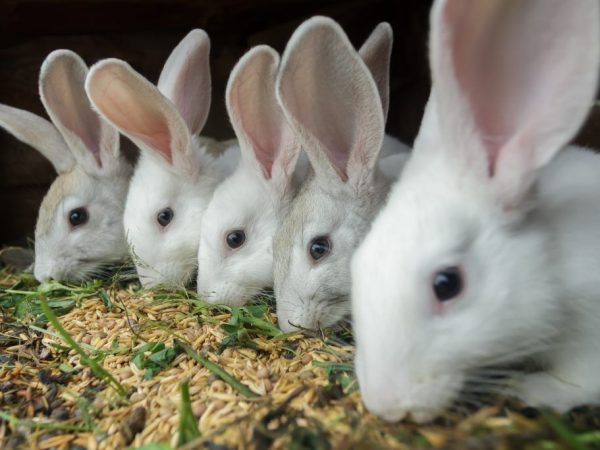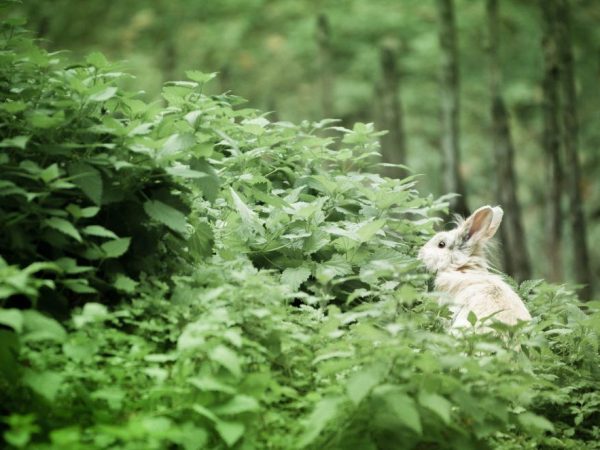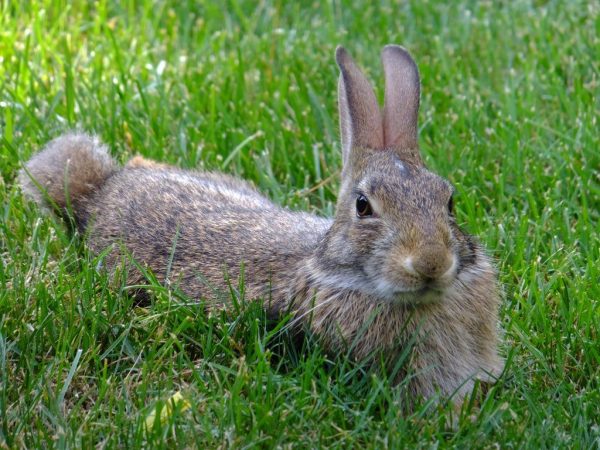What grass can be given to rabbits and which not
The dietary regime has a huge impact on the health and productivity of the furry inhabitants of the rabbitry. Only the breeder can decide what kind of grass to feed the rabbits, and what it is better to refuse. Correctly selected green food and the composition of a balanced diet helps to improve the reproductive qualities of the livestock and the taste of meat.

Choosing grass for rabbits
It is the grass that is the main food element for eared pets. In summer, they give fresh juicy healthy greens, in winter - harvests of herbs dried from summer. Greens and hay are the main sources of proteins, vitamins, minerals and other nutrients needed throughout the year. If you understand what kind of grass your wild rabbits love, you will always know how to please your pet.
Benefits
Advantages that make grass an essential ingredient that no meal can be without:
- By introducing green complementary foods into the daily menu, you can reduce the amount of grain foods and dry compound feeds consumed.
- Legume shoots are rich in proteins and amino acids, they give a quick weight gain.
- Thanks to plant fibers, the digestive processes are faster.
- Grass stalks are not only delicious food, but also a great tooth sharpener.
- Green food helps to increase the amount of milk in females during lactation and effectively fights inflammation.
In order not to spend money on sowing clover and other useful grass for rabbits, you should look for pet food in the wild. A lot of tasty and useful things grow there: wormwood, porridge, dandelions and so on.
Knowing what kind of grass is permissible to feed rabbits, you can easily prepare hay for future use.
Conditions
There are universal requirements for any plant that is added to the diet of animals:
- As feed, rabbits are given only young grass, which contains a large amount of protein and few plant fibers. The older the grass, the less nutrients it contains. In addition, feeding animals late in collections can provoke problems with the gastrointestinal tract.
- You cannot eat the same plant for a long time, this will provoke health problems for the pussies. It is necessary to achieve a variety in nutrition, for this it is advisable to mix several types of fresh complementary raw herbs.
- Having learned what kind of grass rabbits can use, there is no need to rush to treat it to pets. You can not feed the fluffs with freshly cut or wet grasses: this will lead to indigestion. The green delicacy is given a little dried.
- You should not mow the grass with a mower, otherwise oxidative processes will begin in it and the food will turn from useful to poisonous, causing indigestion.
- Fresh stems and leaves contain a lot of protein, so you need to switch to grass food slowly, from an early age.Every day, it is necessary to gradually increase the percentage of greens in the diet, while always monitoring the reaction of the wards.
- Grass mown at the moment when it just started to gain color, that is, immediately after the formation of buds, is used as winter blanks.
- Properly dried hay given to rabbits in winter should be green and smell fresh.
North
If you have no time to walk through meadows and fields in search of what grass to feed your rabbits, there is an excellent alternative: it is permissible to sow and grow it in your personal plot. What grass can be fed to rabbits in this case? You need to buy any several types of seeds from the proposed list:
- red clover (contains the most protein, approximately 20-22% during the budding period;
- alfalfa (a rich source of protein and amino acids, needed by females during breastfeeding and by rabbits);
- green peas (eared peas are very fond of peas, especially if its stems and young pods are slightly dried beforehand);
- vetch (served with oats or rye, cut either in early June or in the first half of autumn);
- corn (best mixed with legumes in a ratio of 70% corn to 30% of the rest of the grass);
- sida (useful perennial crop, you can mow several times during the year);
- sulfium (it manages to grow twice over the summer, contains a lot of nutrients, in composition it is similar to alfalfa and clover);
- rhubarb (the earliest, but no less useful herb, harvest should be from late spring to mid-summer);
- a fodder variety of lupine (contains a lot of protein, refers to legumes, they should be fed in a mixture with other herbs: as an independent feed, it can cause stomach problems);
- porridge (hybrid type of clover, rich in proteins, blooms in late May-early July, an excellent alternative to mountain clover and honey plant growing in groves).

Types of seeds for feeding rabbits
Especially carefully it is required to add legumes to the diet; this should be done gradually in small portions, preferably after mixing with any cereal. Rabbits prefer grape, plum, bird cherry leaves and elderberry as food. You can pamper pets while feeding carrot and beet tops from the garden, mixing with other grass in equal proportions.
Before serving the beet tops, mix it with a little chiselled chalk to neutralize its laxative properties, and then add it to the rest of the hay. But you should not feed the fluffy potato leaves: they contain a lot of poisonous solanine.
Healthy Wild Varieties
Medicinal dandelions are considered the most popular wild-growing food variety. They contain a huge amount of proteins that stimulate muscle growth and a little fiber, which increases the appetite of furry. Everything should be in moderation: an overdose of dandelions will lead to a decrease in the growth of young animals.
To increase the milkiness of lactating females, a little Siberian hogweed leaves are added to the menu; you can find it in forest glades. The stems are not suitable for feed.
Nettles, both fresh and dried, are good for rabbits. The herb is not only rich in protein, but also has a beneficial effect on the functioning of the digestive organs. Effectively relieves mother-and-stepmother stomach problems. This medicinal herb ripens at the end of May.

Nettles in the diet of rabbits
Runny is a very useful plant that is often found among the weeds in the garden. The most useful are forest types of grass that do not bloom.
Complementary feeding is also carried out by nutritious wheatgrass rhizomes. When dried, they can be stored for 3 years. You can combine wheatgrass with fresh plantain, which is rich in proteins and minerals, but fiber, on the contrary, is less than most other herbs.
Thyme ordinary, or thymus vulgaris, is a very tasty herb that even fastidious decorative rabbits love.
For deworming, wormwood collected in early autumn can be fed to animals. In large quantities, the grass causes overexcitation of the nervous system of pets, therefore it is better that the amount of this plant does not exceed 40% of the total daily diet: this way it will be possible to effectively treat worms without harming the internal organs of the rabbit.
There are other useful wild herbs. It is permissible to diversify the pet's diet with yarrow, ivan tea, tansy, shepherd's bag and even burdock. Fluffy rodents are very fond of carrots, sweet clover and American.
Drying collections for the winter should take place in the shade in the fresh air. To do this, lay out the grass on a stretched net or on sticks, folding them in a hut.
Harmful feed
Knowing which grass should not be given to rabbits is very important, because one mistake during feeding can lead to illness of the entire livestock.
Plants are considered poisonous, harmful to the health of fluffs:
- stale, moldy, rotten;
- dirty, especially those that were collected on sites where dogs and cats are walking;
- freshly cut and wet from rain and dew,
- growing near busy roads and highways
- those in which the norm for the content of substances harmful to rabbits is exceeded;
- decorative poppy, jasmine and buttercup varieties;
- most indoor flowers;
- greens canned and frozen for the winter.
Any disturbances in the work of the gastrointestinal tract are considered common signs indicating food poisoning: diarrhea, vomiting, bloating, etc. decrease or increase in body temperature; numbness of the hind limbs; increased salivation, heart problems. There can be as many symptoms as there are options for poisoning.
We looked at what grass is not allowed for rabbits, even if it does not contain poison, but there are other plants that are poisonous, even when properly collected and harvested.
Wild-growing harmful species
Plants containing poison and symptoms of poisoning:
- Marsh calla. Animals start to panic, stomachs swell, other problems appear with the work of the digestive tract, and drool constantly flows from the mouth.
- Spotted hemlock. Outwardly it looks like parsley and carrot tops. The high content of cicutin, ethylconicin and methylconicin in the grass leads to paralysis of the hind limbs and respiratory organs in the animal that has tasted it. Some time after eating, the animals begin to have severe convulsions, the body becomes cold.
- Common St. John's wort. Due to the fact that it usually grows along highways, the plant absorbs a lot of poisonous exhaust, dangerous not only for animals, but also for humans.
- Poisonous milestone. The poisoned people stop breathing, in addition, their hind legs are paralyzed and convulsions begin.
- Ordinary dope. It also leads to paralysis, but it also negatively affects the work of the heart.
- Milkweed stalks. The poisonous white liquid that each branch of this plant contains provokes gastrointestinal disorders and seizures.
- Celandine. The use of large quantities of grass by rabbits leads to the fact that they become lethargic, inactive. Bowel problems may occur.
- Doll. A weed that often grows between rows of noble crops. Accidentally eating rabbits, it leads to disruption of the heart and kidneys, gastrointestinal disorders and increased saliva production.
- Marsh marigold. Poisoning leads to the development of severe diarrhea, stomach cramps, continuous urination and gastrointestinal disorders.
- Buttercups. These beautiful bright yellow flowers are very harmful to the eared ears. All because of the high content of protoanemonin in them. This ingredient causes diarrhea, severe weight loss, and bloating.
The above is only a small part of the plants that can harm the health and life of eared ears. It can take a long time to list the types of greenery that is very dangerous for fluffy wards, and it is almost impossible to remember all of them.

Harmful grass for rabbits
We can weed out some poisonous herbs for rabbits on an intuitive level. For example, farmers subconsciously bypass quinoa and mustard shoots, knowing from childhood about the properties of these plants and realizing that they will not bring anything good. In contrast, there are such beautiful and visually delicious flowers as buttercup, which is no less dangerous.
It is required to carefully check the hay before feeding it to pets. It is permissible to give the wards only those herbs in the use of which there is 100% confidence. If by its appearance it is impossible to understand what kind of grass it is, you need to find its photo in a reference book and carefully compare it with a twig plucked in a meadow. Lawn greens should always be avoided, even if they are one of the favorite treats for pets: it is still harmful grass for rabbits.
Useful Tips
- Despite the fact that clover is one of the foods allowed for rabbits, it should not be given to pets in large doses: it can provoke a slight intestinal upset.
- It is better to harvest alfalfa as soon as the first inflorescences appear on the plant. There is almost no benefit from later mowing.
- Oats can be harvested 2 times per summer season. Immediately after the first shoots are mowed, the earth is dug up and sowed again.
- Sida is grown as an ornamental plant, which bees love very much. By planting it close to other crops, you can provide them with additional pollination.
- To whet the appetite of the eared ears, you can feed them with parsley or celery.
- The meat of animals that were fed with mint, caraway seeds and dill during their lifetime is much more aromatic and tasty than others who were less fortunate.
- Nettles, before giving to rabbits, should be dipped in boiling water, cut into small pieces and added to herbal feed.
With this little but very useful knowledge, every farmer can easily understand which grass is good and which is not. So, knowing what kind of grass rabbits eat, its description and names, and carefully studying their photos, you will definitely collect the best green mixture for your pet: the most delicious, the most useful and the most nutritious. The main thing is to always try to maintain a balance of vitamins and beneficial microelements. In addition, one should not forget about the variety of the diet.


